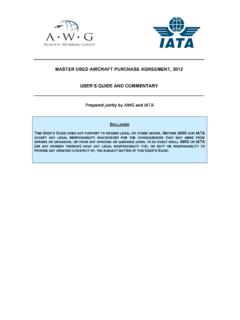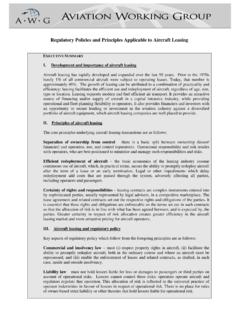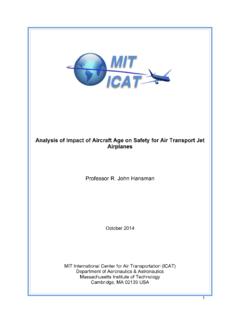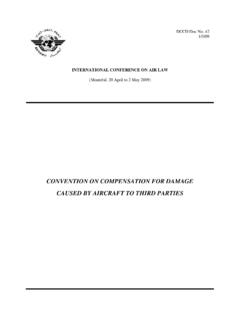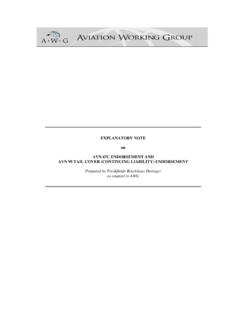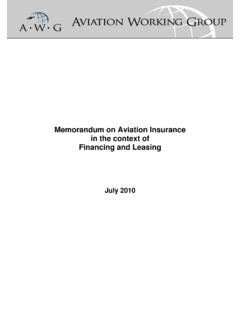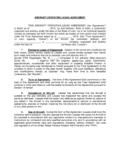Transcription of Summary of 2011 Sector Understanding on Export Credits for ...
1 Summary of 2011 Sector Understanding on Export Credits for Civil aircraft February 2011. Background With effect from 1 February 2011, the OECD countries plus Brazil ( Participants') have agreed to a new aircraft Sector Understanding ( 2011 ASU'). The 2011 ASU supersedes the 2007 aircraft Sector Understanding ( 2007 ASU'), which superseded the prior agreement that has governed Export credit since 1986 (to the extent addressing large aircraft , LASU' focused on large aircraft ). Unlike the 2007 ASU, which made a distinction between aircraft models,1 the 2011 ASU. establishes a single system, that is, the same terms and conditions apply regardless of the aircraft model.
2 Grandfathered Transactions The 2011 ASU does not govern Export credit for either (i) grandfathered transactions, which are governed by the 2007 ASU, or (ii) great-grandfathered transactions, which are governed by LASU. (save that the premiums applicable thereto may not be lower than 3%). That includes premium, structures, and discounts. Grandfathered transactions' are deliveries that occur, in the case of Category 1 aircraft , by 31. December 2012, and, in the case of Category 2 / 3 aircraft , by 31 December 2013,2 in either case where the financed aircraft was subject to a firm contract concluded not later than 31 December 2010.
3 A firm contract' means a binding commitment between the manufacturer and the person taking delivery (including under a sale-leaseback with a lease term of at least 5 years). A. commitment fee (with different starting times) of 20 basis points per annum is payable. Great-grandfathered transactions' are a subset of deliveries, previously notified (30 June 2007). to the OECD Secretariat, scheduled to occur on or prior to 31 December 2010 in accordance with firm contracts concluded not later than 30 April 2007. The subset is 69 aircraft per each Participant 1. All Airbus and Boeing commercial aircraft in production, except the A318 and B737-600 were designated as Category 1 aircraft ', and all other commercial and executive aircraft , including the A318 and the B737-600, all aircraft manufactured by ATR, Bombardier, Embraer, and MJET and all helicopters in production were designated as Category 2 aircraft ' or Category 3 aircraft '.
4 These terms will be used in this Summary as and when necessary. 2. Each Participant that supports Category 2 aircraft is permitted an additional 92 aircraft with no delivery date limitation. 1. that supports Category 1 aircraft . Such country must submit a transition list of 69 selected aircraft by 31 January 2011. A commitment fee of 35 basis points per annum is payable, accruing from the earlier date of the final commitment or 31 March 2011. There is no delivery date limitation. The identity of the borrowers on the transition list will be managed exclusively by the Secretariat and not shared with Participants.
5 Financial Terms and Conditions under the new ASU. Generally The new ASU sets out the most favourable terms and conditions on which officially supported Export credit may be provided. In other words, the new ASU sets minimum rather than mandatory rates to be charged by the Export Credit Agencies (ECAs). There are a number of eligible currencies: euro, Japanese yen, UK pound sterling, US dollar, and other fully convertible currencies. Export credit may take the form of pure cover (guarantees) or direct lending. Where direct lending is provided, a minimum interest rate shall be charged (LIBOR, for floating rate loans, and 7-year swap rate, for 12-year fixed rate loans).
6 3 In addition, margin benchmark (liquidity premium) will be charged. That will be set on a monthly basis. The maximum repayment term is 12 years for all new aircraft . A 15-year term may be offered on an exceptional basis, with prior notification, and with a 35% surcharge on the MPR, described below. The term may not be extended through pari passu sharing of security rights. Repayment is to be made on a quarterly basis. Semi-annual repayment may be offered with a 15% surcharge on the MPR. Minimum Premium Rates A minimum premium rate ( MPR') shall be charged. The MPR is equal to the sum of the applicable (i) risk-based rate ( RBR'), which is meant to reflect and price risk, viewed through the business cycle, and (ii) market reflective surcharge ( MRS'), which is meant to balance Export credit pricing with commercial market pricing at any point time.
7 A maximum reduction of 10% off the MPR ( Cape Town Discount') is available if the operator4 is based in a country that ratified the Cape Town Convention, made the qualifying declarations,5 and properly implemented the treaty. A list of States whose borrowers are eligible will be maintained by the OECD Secretariat. 3. For aircraft with a net price of at least USD 35 Million, CIRR rates may be offered but only on an exceptional basis. All Participants shall be notified. 4. Or the borrower/buyer or lessor, if in the view of the Participant providing official support, the structure of the transaction so warrants.
8 That is a more flexible standard for lessor /borrowers than in the 2007 ASU. 5. As defined in Annex 1 of the 2011 ASU ( qualifying declarations' means (i) insolvency (Protocol, art X, Alternative A (with no more than a 60 calendar day period),(ii) deregistration and Export (Protocol, art XIII), (iii) choice of law (Protocol, art VIII), and (iv) either (a) non-judicial remedies (Convention, art 54(2), or (b) expedited court remedies, Protocol, art X). Certain other declarations would be disqualifying. 2. The initial MPRs, with and without the Cape Town Discount, are set out in the Annex 1. The premium may be paid either upfront or, over the life of the facility, as spreads expressed in basis points per annum.))
9 In the case of pure cover, MPR shall be charged as an upfront fee, or if financed, as a per annum spread. In the case of direct lending, it shall be embedded in the overall interest rate. Annex 1 also lists the system of borrower classification, which determines, among other things, the applicable All borrowers are placed in one of the eight (8) risk categories ( RC') set out in the Annex 1. Periodic Premium Adjustments There is a complex system for adjustments to the MPR. It has the potential for volatility. The RBR, initially fixed with reference to historical (non- aircraft ) secured bank debt rates, is reset annually based on a 4-year moving average of the annual Moody's index of loss given default data on senior unsecured bank loans in Moody's data base.
10 The first reset is scheduled for the 1st quarter of 2012 and the resulting RBRs will become effective as of 15 April 2012. The RBRs resulting from subsequent reset processes will be effective as of 15 April of each following year. The MPR (which result from the RBR and MRS) shall not exceed the RBR by more than 100%. For each risk category, a MRS shall be calculated. The MRS are based on 90 day moving averages of Moody's Median Credit Spreads ( MCS'). The MCS spreads (which are unsecured rates) are discounted by 50% to account for the asset-security and subject to different blend coefficients' depending on the risk category.
